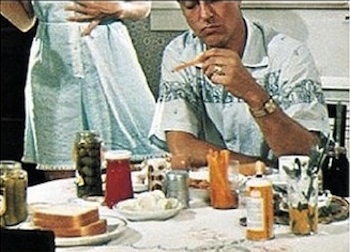
John Baldessari, "Yours in Food" book jacket image. Princeton Architectural Press, 2004.
Gastro-Vision is a new monthly column dedicated to all things food in contemporary art and visual culture. This month’s post also falls under the Flash Points topic, Systems.
Yours in Food — by Season 5 artist John Baldessari — had, like many other books, been on my Amazon wish list for a couple of years. When I stumbled upon a used copy at Biography Bookshop in Manhattan (note: across the street from Magnolia Bakery) this summer, what had before appeared fun and frivolous seemed a requisite purchase.
Flipping through, I found provocative images of food, dinner tables and eaters, appropriated from film and video as is characteristic of Baldessari’s work. A group of young men wearing overalls and plaid shirts seated for a meal of mashed potatoes, milk and other ostensibly hearty foods suggests a rural working class family. The face at the head of the table is covered by one of Baldessari’s signature colored dots. In other images, a banquet table procession of porcelain dishware and brass candelabras, flanked by women in sequin dresses and pearls, speaks to high society. A picture of stainless steel cafeteria trays and husky men in denim blue shirts hints at a prison scene. Baldessari inserts his hand again in a candid black-and-white shot of a lodge-like dining scene; a series of white circles obscure the faces of white males, suggesting homogeny and self-segregation. On the book jacket (above), jarred pickles and olives, ketchup, a stack of white bread, and what resembles a can of Cheez Whiz, call to mind the all-American pantry. Between these vignettes, Paul Auster, Peter Schjeldahl, David Bryne, Lynne Tilman, Tim Griffin and other notable writers share tales of love, loss and toast; poverty and onion pie; Thanksgiving gluttony; and other reflections on “taste.” Yours in Food is, on the whole, a study of the shared meal, or “breaking bread.”
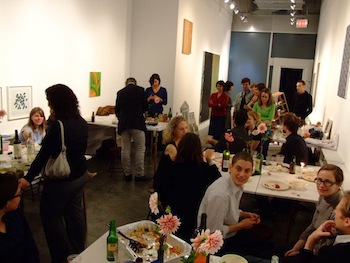
"Don't Perish" Dinner #3. Courtesy Joseph Montgomery and Jesse Willenbring.
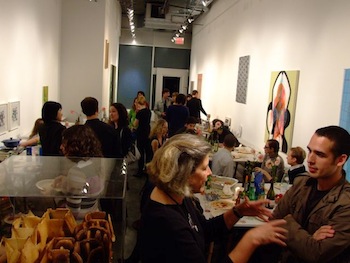
"Don't Perish" Dinner #3. Courtesy Joseph Montgomery and Jesse Willenbring.
“The act of sharing food and drink with others is…an enduring source of aesthetic inspiration,” writes Stephanie Smith, curator of the forthcoming exhibition Feast: Radical Hospitality and Contemporary Art, “Today, the shared meal has become a compelling artistic medium.” Every so often it also inspires a whole curatorial thesis. For the exhibition Don’t Perish, recently at Leo Koenig Inc. Projekte in Manhattan, curators (and practicing artists) Joseph Montgomery and Jesse Willenbring invited friends and strangers to look at work with them “over a meal.” This group show, dinner series, and food-drive in one–an alternative to passive viewing–involved nine potlucks at the gallery spread out over four weeks. Similar to Baldessari, Montgomery and Willenbring demonstrate how the shared meal is itself a system, or paradigm by which to engage viewers in a concept and body of work. Montgomery says:
We had anywhere from 15 to 30 people per night. Tuesday nights were very crowded. Saturday nights on the smaller side. Conversations changed the work…Everything was not original; conversations were repeated [and] similar dishes cooked, but the act of being there again and again brought strength and endurance to the show…All the smoke, smells, looking, colors, breath, and words were absorbed, polished into the art, tables and shelves.
Montogomery and Willenbring mounted a similar project in 2008, a tribute to Rirkrit Tiravanija entitled Rose Colored Glasses. Works were installed around a dinner table, “dispersing the focus from the singular provider to multiple sources of food and art in one space.” But the curators were disappointed with the outcome. “The idea of potluck did not seem to translate into a workable and sustainable method of sourcing generosity in aesthetics,” says Montgomery. Don’t Perish was an attempt to fix these “deficiencies.” Dinnertime chatter, collective reflection and a bit of food philanthropy brought the exhibition to its full potential.

"Don't Perish" installation. Courtesy Leo Keonig Inc. Projekte.
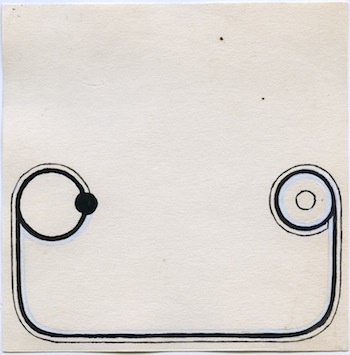
Jo Baer, "Hiccup," 1964. Gouache on paper, 4 x 4 in. Courtesy Leo Keonig Inc. Projekte.
The process for selecting objects began with the understanding that Montgomery and Willenbring would spend almost 150 hours over 30 days in the gallery “wrestling with installation, hosting dinners, eating and drinking.” And so, they set themselves up for “prolonged exposure.” Think Slow Food come to contemporary art. “Abstract and conceptual works,” according to the curators, “lent themselves particularly well to durational viewing.” Peppering the long white cube were two miniature drawings by the minimalist artist Jo Baer, titled Hiccup and Garden. Further down this wall hung a piece of blue velvet fabric by Alison Fox titled Untitled/Smurfblue. Given the framework, I want to read Fox’s grid-adorned blue sheet as an interpretation of a picnic blanket or tablecloth with a nod to Barnett Newman and Sol Lewitt. Conscientious of generational references, a Pat Steir painting was installed next to a Sherrie Levine piece, and across from a work by Alexandra Olson. Montgomery says, “A guest that comes multiple nights might, for example, be consumed by the layers of Carrie Moyer’s piece [during] the first dinner, and move on to the pours of her antecedent, Steir, the next [time].”A mushroom sculpture by Cosima von Bonin; a staid string and nail piece by Carol Bove; a color field C-print by Roe Ethridge titled Dust Cover; and Hilary Berseth’s Programmed Hive #7, a three-dimensional sculpture of honeybee comb mounted on board, were also include in the display.
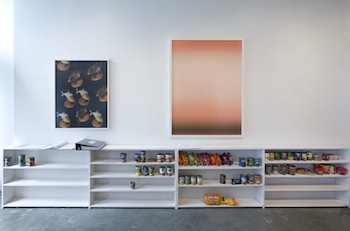
"Don't Perish" installation. Top left: Roe Ethridge, "Piranha," 2008. C-print, 38 x 30 in. Top right: "Dust Cover," 2008. C-print, edition 2 of 5, 55 1/2 x 42 in. Courtesy Leo Keonig Inc. Projekte.
On the flip side of dining and digestion was an emphasis on hunger and responsibility: a series of white shelves functioned as an impermanent food pantry, “making generosity visible” through the display of donated food. The presence of non-perishable goods in the gallery signaled the problem and absence of food elsewhere. (The Feeding America Network, made up of more than 200 food banks and food rescue organizations, distributed nearly 2 billions pounds of food and grocery products in 2005 to more than 25 million Americans. At the same time, the USDA estimates 96 billion pounds of food are wasted each year in the United States.) Donations to Don’t Perish—a prodigious 400 pounds when it was all said and done—were given to the Food Bank for New York City. Looking at the statistics, I had to wonder, what now? How will the curators continue this (very timely) dialogue of responsibility post-exhibition? Montgomery said:
“…Acknowledging influence is to engage responsibility as a known quantity in the art world. Processing these shows takes a long time. Now we wait. If we communicated something about responsibility, the person or persons who engaged in the conversation will perpetuate it themselves. That’s what responsibility is, right? Influence then action, right? We are excited to see if and how that might grow.”
But wait, there’s more. The curators’ eating and feeding endeavors also included a weekend farm stand outside the gallery (located in an area of Chelsea where the pickins are slim). Many farmers didn’t have time or resources to help with the project, says Montgomery. But the farmers that did participate were “sympathetic to or had first hand knowledge of the art world.” They said, in splendid metaphor, “Growing food is hard, but understanding art is also hard work and we want to help set up the dichotomy.”
John Baldessari is featured in the Season 5 episode “Systems,” premiering Wednesday, October 28 at 10pm (ET) on PBS. Stephanie Smith’s aforementioned exhibition, Feast: Radical Hospitality and Contemporary Art, is scheduled to open at the Smart Museum of Art, University of Chicago, October 2011.



